Pientenpol Web Page
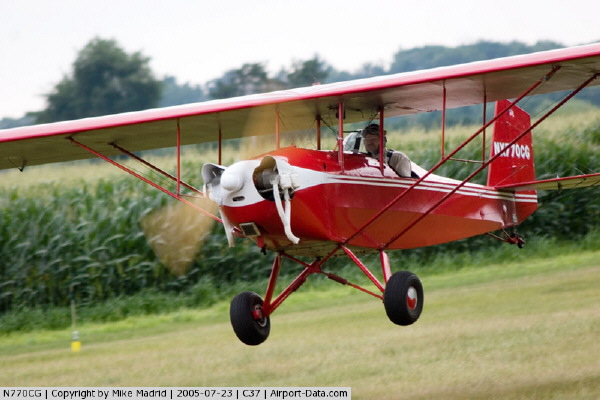
Copyright 2007 by Richard Harris
Copyrighted Photos Courtesy of Chuck Gantzer and author.
First photo Copyright 2005 by Mike Madrid
TEMPORARY - 8/29/2007
To VIEW LARGER IMAGES,
click on any picture below,
and you'll be transferred to its larger version.
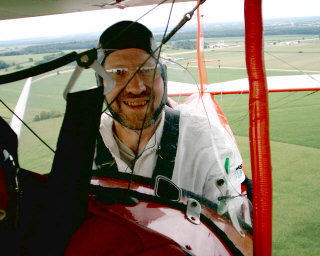
CAPTION: Smilin' Chuck Gantzer, aloft in his own handiwork. Few planes offer you the great earthward views you can experience in a Pietenpol AirCamper. Gantzer has especially enjoyed sharing the view with grown sons Chucky and Tommy. This is one of the many camera angles shown in Gantzer's commercial video of his great adventure -- a 3,100-mile aerial odyssey, from Wichita to Texas to Oshkosh to West Virginia and back -- in this cockpit. But it wasn't always this way. A lot of work went into making him master of his own delightful creation.
CREDIT: (C.Gantzer at www.nx770cg.com)
________________
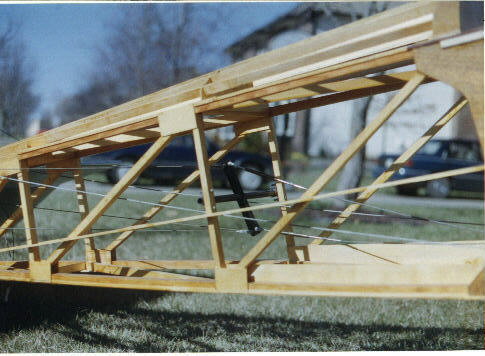
CAPTION: The wood-and-wire aft fuselage is a classic example of scratch-built Pietenpol design. Love of woodworking is a big help here. Begun with the help of Doug Bryant, who'd already built another AirCamper, Gantzer's aircraft took several years' craftsmanship, and loving attention to delicate details. "It's a hobby," he explains. "If you play golf, or whatever your hobby is, we don't keep track of how many hours we spend with our hobby. It's a labor of love. It's an enjoyable process." Gantzer's popular Pietenpol website -- www.nx770cg.com -- supplies lots of fascinating details of the process.
CREDIT: (C.Gantzer)
________________
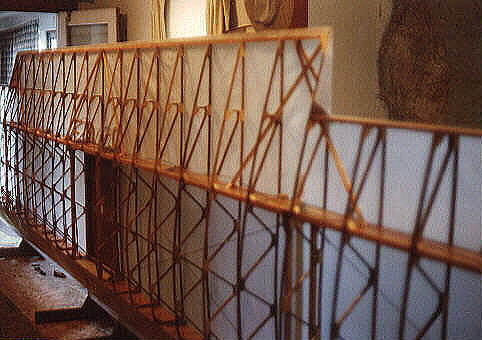
CAPTION: The intricate wing structure requires lots of time and patience, and a place big enough to hang a wing and work on it. Nearly all the parts are wood, but Gantzer -- who's done a study on the history of Pietenpol accidents -- says no properly built Piet' has ever fallen out of the sky due to a structural failure. Though a certified A&P mechanic, "I originally got into aviation with model airplanes," says Gantzer. "I designed and built quite a few unique model airplanes. What basically you're doing [building a Piet] is just building a great big model airplane. The physics are all the same, they all obey the same laws of physics -- which are rigid & non-negotiable."
CREDIT: (C.Gantzer, www.nx770cg.com)
________________
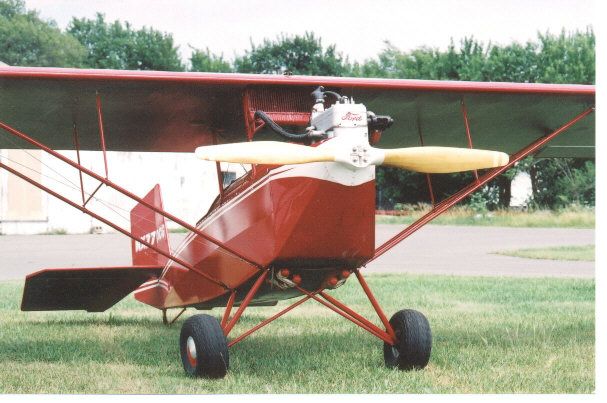
CAPTION: Finished product, in original form, following the original plans calling for a Ford Model A engine. "The Pietenpol grandpappy of all homebuilt aircraft." says Gantzer. "A simple-to-build airframe designed around a readily aviailable engine -- the Model A Ford." Bernard Pietenpol designed the AirCamper to be built affordably by the common man, and -- in the depths of the Great Depression -- this was the cheapest suitable engine. Note radiator hanging from the wing. The pilot looks ahead underneath, although some Piet's have the forward view completely blocked by radiator and/or engine.
CREDIT: (C.Gantzer, www.nx770cg.com)
________________
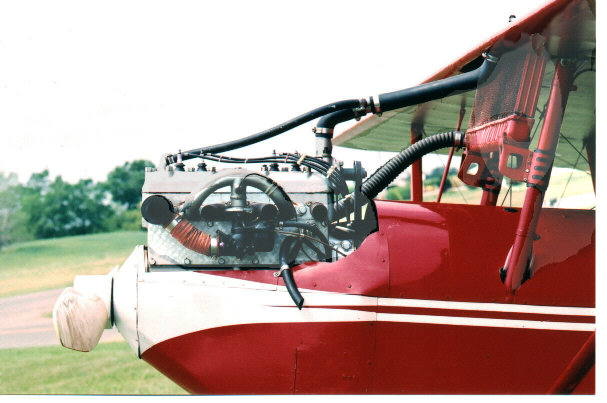
CAPTION: Belting out about 40 hp (Gantzer says his was only putting out about 35 hp), the Ford offers a cheap power source. "Henry Ford built 5,000,000 of them, and they're good engines," says Gantzer, "so plenty are still available, cheap."
CREDIT: (C.Gantzer, www.nx770cg.com)
________________
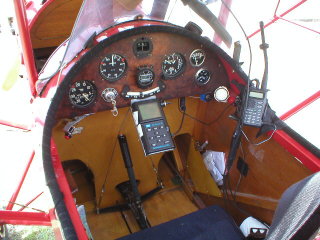
CAPTION: The AirCamper's snug cockpits are a challenge to enter and exit, especially if you're equipped with properly mounted "handheld" Nav/Com and GPS. Otherwise, instrumentation is bare-bones IFR: Airspeed, altimeter, balance ball (no turn needle), magnetic compass, stopwatch, and engine gauges. Gantzer's burled-walnut panel adds a touch of vintage class.
CREDIT: (C.Gantzer, www.nx770cg.com)
________________
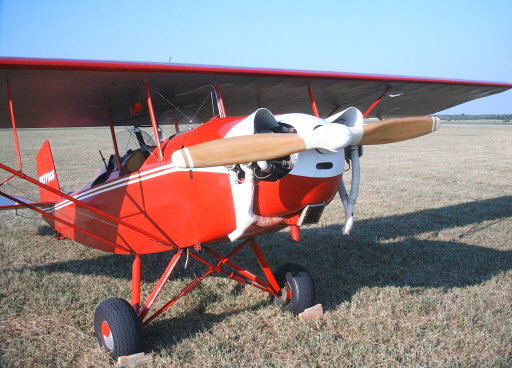
CAPTION: Upgrading from Ford to Continental brought new life to Gantzer's Piet. Salvaged from a '47 Cub, this most classic of small airplane engines, the Continental A-65, provides an honest 65 horsepower, in a much more reliable engine than the fragile old Ford (Gantzer decided on the change after his third forced landing). Air-cooled A-65 uses no radiator, so forward view aloft is greatly improved. The Continental, he estimates, puts out about double the horsepower, but is 60 pounds lighter, for better useful load and much better takeoff and climb performance, especially on hot days. Cruise, though, remains around 70-75 mph. "With a Piet, you're just not going to go that fast," says Gantzer, pointing to the orchestra of struts and wires that fill the air around a Piet. Front cockpit, under the wing, surrounded by struts and wires, and well above ground, is an acrobat's challenge to enter, making it best suited to the slender. Gantzer, normally operating from paved fields, prefers the conventional small tires which work best on pavement, but many Piet's use tall wire wheels for better landings in rough fields -- not a rare requirement when flying with an antique Ford engine.
CREDIT: (R.Harris)
________________
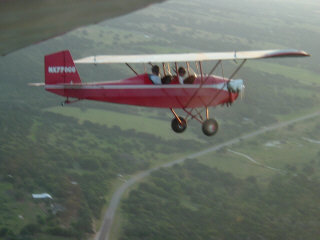
CAPTION: Sharing the joy, Gantzer and friend fly formation with another Piet pal. The Continental-powered Piet provides the push to propel a pair to the pinnacle of piloting pleasure. Even with the Continental, though, cool days work best for this, because the low-powered, small-wing Piet struggles aloft with two aboard. Every Piet's parasol wing offers a great, shaded aerial view of the earth. Free of the Ford radiator, Chuck's air-cooled Piet provides an especially fabulous, open-cockpit view of the world.
CREDIT: (Courtesy of C.Gantzer)
________________

CAPTION: Proud Papa presents his pretty plane at Pietenpol party. Gantzer at Broadhead, WI -- home to the annual Pietenpol fly-in -- just before Oshkosh's AirVenture, down the road. A delightfully down-to-earth gathering of AirCamper enthusiasts, the Broadhead experience has been a wonderful source of information and comraderie for Piet lovers, many whom (like Gantzer) made a really long aerial trek, low-and-slow, to get there. The secret of success in creating your own airplane, and enjoying it, says Gantzer, is to "just do it."
CREDIT: (Courtesy of C.Gantzer)
________________









